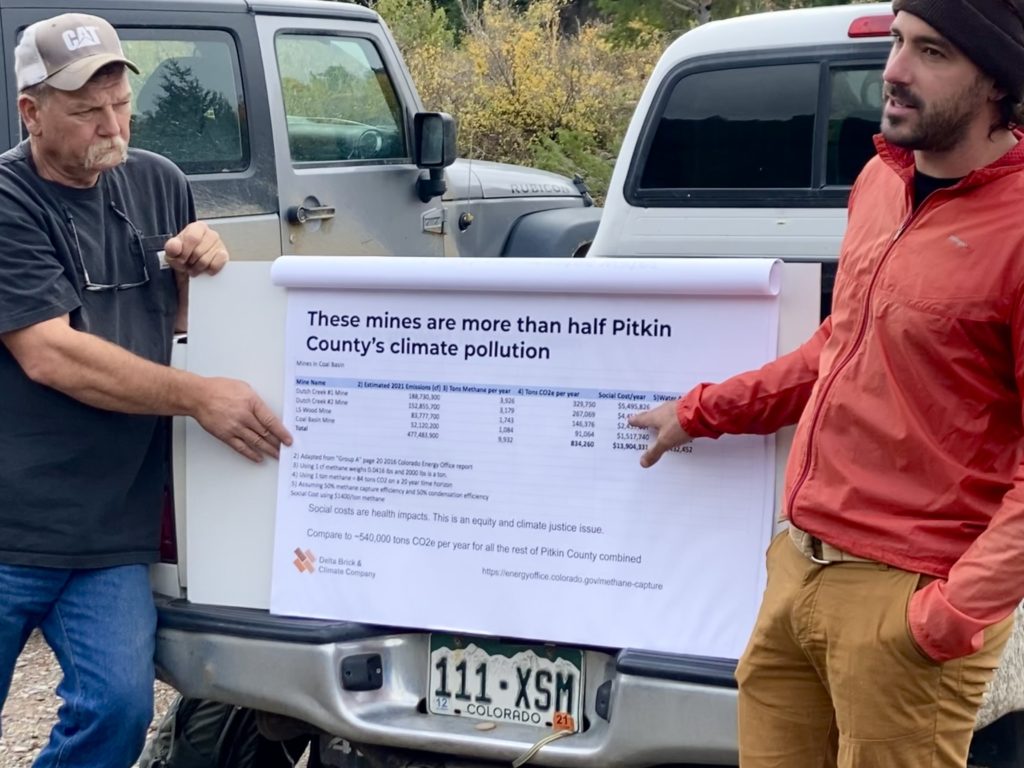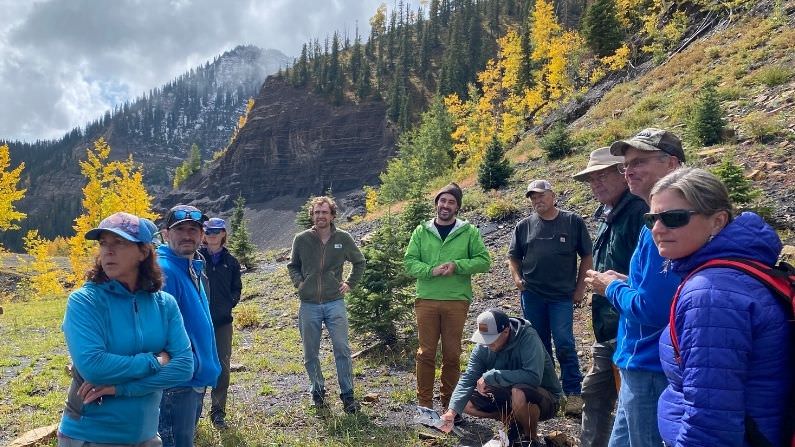This story is part of a collaboration with Rocky Mountain Community Radio focusing on the transition away from fossil fuels across the Mountain West.
As the impacts of climate change worsen, many are turning their attention to the harmful greenhouse gas methane. Scientists estimate methane is more than 80 times more potent than carbon dioxide. President Biden and other global leaders have promised to cut 30% of methane emissions by 2030.
Now, Pitkin County, in Western Colorado, is working with a group of stakeholders to capture a large amount of methane that’s been leaking out of abandoned coal mines in an area known as Coal Basin, above the town of Redstone. The area is about 45 road miles from Aspen.
In late September of last year, representatives from Pitkin County, Holy Cross Energy, Sen. Michael Bennet’s office and others hiked nearly nine miles through golden aspen groves to witness the problem firsthand.
Paonia-based climate scientist Chris Caskey crouches in front of an old mine portal in Coal Basin that’s been filled in with rocks and dirt. He uses a methane sensor to show the group where a steady stream of air and methane is leaking out from a small hole in the porous earth.
“You can see those little wild roses are blowing in the breeze,” Caskey said. “That breeze is mostly air that’s entering down lower and coming up through, but we measured it earlier, it’s almost 2% methane by volume.”
Coal Basin was once dominated by coal mines that were first opened by coal baron John Osgood in the late 1800s and were later redeveloped by the Mid-Continent Coal and Coke Company in 1956.
“This coal was saturated with natural gas, mostly methane, and that’s just for geology reasons,” Caskey said. “That methane is a minor safety hazard, so during mining it was vented to protect the miners, and that methane has continued to leak out ever since.”
When the last of the five mines shut down in the early 1990s the mining company was mandated to restore the area, but it went bankrupt and left behind polluted water and a scarred landscape.
Over the last several years, local stakeholders including private landowners and Pitkin County Open Space and Trails restored parts of Coal Basin and created a public trail system and a recreation area called, “Coal Basin Ranch.”
Despite restoration efforts over the years, Caskey estimates the old mines are leaking over a million cubic feet of methane every day. According to local officials, that’s equivalent to over half of Pitkin County’s reported CO2 emissions each year.
“That includes all the traffic, all the houses, all the aircraft landing at the Aspen Airport,” Caskey said. “And Pitkin County being wealthy is not a low footprint place.”
According to Caskey, the methane seeping out of the mines isn’t concentrated enough to impact hikers or mountain bikers, but it is making its way into the atmosphere and contributing to climate change.
“So, this is very significant and it’s a huge opportunity to reduce climate pollution,” he said. “If we can capture this gas and either use it or just destroy it by burning it, that is a very good thing to do.”
For Pitkin County Commissioner Greg Poschman, the expedition up to the old mines made the benefits of taking action clearly.
“This might be the easiest way to get a huge bang for our buck to reach our carbon goals, certainly by 2030, if not sooner,” he said.

Climate scientist Chris Caskey and mining infrastructure expert Eric Edwards present a graph showing the amount of methane leaking out of the abandoned mines in Coal Basin. Caskey estimates that the fugitive methane is equivalent to over half of the county’s reported CO2 emissions each year. (Eleanor Bennett/KAJX)
According to the stakeholder group, the cheapest solution would be to burn the methane, which creates CO2 instead.
“And that really looks like wasting it,” Caskey said. “But right now it’s already being wasted, and CO2 is less bad for the atmosphere than methane.”
Another option the group is considering is to use the gas leaking out of the mines to generate electricity.
“Do we want to have a small power plant and have a microgrid here in the Crystal River valley?” Caskey said. “Or do we want to put it in a pipeline and run it to every house in Redstone…these are all possibilities.”
In addition to CO2, burning methane also creates steam, which Caskey said can be condensed into water that could then be released back into the local watershed.
“We can make a thousand gallons of liquid water a day,” he said. “That’s not a lot from a streamflow perspective, but there’s no new sources and we’re in a drought.”
In all of these scenarios CO2 would still be released into the atmosphere, but Caskey claims there’s no viable way around that.
“If you give me another two million bucks, I can capture that CO2 and we can figure out something to do with it,” he said. “But for that same two million bucks, it’d be better to go capture methane from another coal mine because it’s quite inexpensive compared to the impact.”
Interest in using abandoned coal mine methane to generate electricity has been growing in recent years, but it’s still a novel idea. According to the Environmental Protection Agency, there were only two projects of this kind in the country as of 2019.
In 2012, Caskey worked with several partners including the Aspen Skiing Company to build a methane capture plant at the Elk Creek coal mine in the town of Somerset. The plant feeds the regional power grid and produces enough electricity to power about 2,000 homes. Caskey estimates the methane at Coal Basin could generate about the same amount of electricity.
While there is much to be learned from the Somerset methane capture project, Coal Basin comes with a unique set of challenges. The mining area is located on a mix of Forest Service, Bureau of Land Management, and private land, which means Pitkin County will need to get permission from individual landowners as well as the federal government.
“A coal mine that’s abandoned and polluting the climate is not something that they have a framework for how to deal with,” Caskey said.
Mona Newton is the executive director of the Aspen-based Community Office for Resource Efficiency. She and the stakeholder group have sent letters to state and federal officials asking for their support. Even with the many bureaucratic hoops, Newton thinks the project is doable now that the Biden administration is in power.
“With the previous presidential administration, there really wasn’t any impetus to work on projects like Coal Basin that will tackle climate change,” Newton said.
In addition to getting federal approval, the stakeholders are also looking at whether building a methane capture plant will disturb the local flora and fauna.
Despite some successful restoration efforts in the area, Commissioner Poschman points out that there are remnants of the coal mining days all around, and Coal Basin is not a pristine environment.
According to Poschman, the engineers hope to minimize construction by using the old power lines and mining roads that still zig-zag up the mountainside.
“I’m not the guy you come to when you wanna reopen a part of the backcountry to heavy trucks and equipment,” he said. “But the infrastructure is in place, there’s no perceived environmental damage.”
For Pitkin County Commissioner Steve Child, the positive impact the project would have on the climate outweighs the environmental impacts of building a small power plant in Coal Basin.
“Our winters now are at least a month shorter, if not more than they used to be,” he said. “So, our area really is in jeopardy of just surviving, and we rightfully are concerned about climate change.”
Newton agrees, but she also said the methane mitigation project shouldn’t be used as an excuse for Pitkin County to keep polluting the atmosphere.
“We can’t stop working on the emissions that are generated within Pitkin County,” she said. “But this will go a long way towards helping to preserve our climate.”
If the project gets approved, construction could start as soon as next year.






